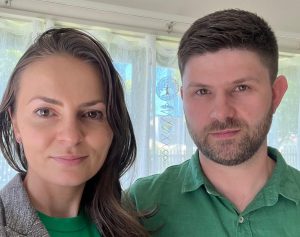Well versed in all aspects of light steel framing, Tibor Kiss, co-owner and design manager at 80 Structures, draws on his broad knowledge to bring accuracy and down-the-line efficiency to every project.
Tibor Kiss and his wife Andrada Kiss, also a structural engineer, arrived in New Zealand from Romania around seven years ago.
Today, they are co-owners and designers at their own family light steel framing company 80 Structures, specialising in cold-formed steel design, engineering, manufacturing, erection, and modularisation.

Focussed career path
The secret to Tibor’s success has been following a career path that has stayed with the light steel engineering trade right through, albeit covering different aspects.
“From early on I have always been interested in engineering – as a kid, I would sneak into the garage and use my dad’s tools for projects.
“One such project was to design, bend and solder together steel water containment tanks for nutria, a beaver-like animal popular in Romania,” says Tibor Kiss. “It’s quite funny, thinking back.
“I also worked in construction when I was around 14 or 15, just helping out friends’ parents building houses.

“And that’s how things evolved – I went to engineering school because I like to build things, and once there I enjoyed doing calculations and reviewing designs.”
A Bachelor of Structural Engineering from the Technical University of Cluj was the outcome.
During those university years, Tibor worked as a manufacturing manager at NLD in Romania – planning production and manufacturing, scheduling steel frame manufacturing and working with the design and sales depts to improve products, performance and forecasting.
“I’ve also actively participated in unloading coils from delivery trucks, operating the framing machine, servicing the framing machine, assembling frames on the factory floor, loading frames onto trucks and orchestrating 24/7 shifts to maintain seamless production operations when required – so addressing all hands-on aspects, too.”
Once out of the university gate, Tibor continued at NLD as a technical manager, leading and managing the Cold-Formed Steel Engineering, Detailing, and Manufacturing departments.
This was followed by Tibor and Andrada moving to New Zealand where Tibor worked as a Design Engineer at Framecad Ltd.
80 Structures
It was from there and with a wealth of knowledge of all aspects of the industry under his belt that Tibor set up 80 Structures – providing high-quality designs of light gauge steel structures for the New Zealand, Australian, and European markets.
Business grew rapidly and Andrada also came on board as a designer –now, 80 Structures was officially a family business.
All aspects considered
“Designers/detailers predominantly focus on drafting, relying on engineering markups to interpret the engineer’s requirements.
“However, our engineering background affords us a unique advantage, allowing us to deliver a comprehensive design ready for review with no or minimal input from the engineer.
“Often, engineers need to make only minor adjustments before approving our plans, cutting back on project delivery times significantly.
“Moreover, my detailed knowledge of the Framecad software packages and their manufacturing system sets me apart.”
Given the software’s integrated engineering capabilities, this allows Tibor to leverage the software to its fullest potential, ensuring optimal outcomes for every project.
Point of difference
With a holistic view that considers engineering, detailing, manufacturing, transportation, and on-site construction, we optimise every aspect of the build to deliver the best results.
Europe vs New Zealand
There were a few points of difference between engineering in New Zealand compared to Romania.
Transitioning from the Eastern European market, where simpler structures were the norm, especially in roof designs, I initially faced challenges adapting to the intricate roof styles – featuring multiple hips and valleys prevalent – in New Zealand and Australia.
Adjusting to different nogging requirements for various cladding types was another aspect to adapt to.
In one way I felt Romania had an advantage – there, we were accustomed to receiving everything in easily editable digital formats, primarily DWG files.
Also in Romania architectural plans typically incorporated gridlines, a practice I highly recommend for clarity and precision – adjusting to working solely with PDF plans, or even hand-drawn ones, was another notable change.
On a human note
Tibor says the work ethic here is to work hard and work your hours – in Romania, long hours and exhausting deadlines were more the norm.
“It is more relaxed here – relaxed doesn’t mean lazy, of course, it just means working reasonably.”
Family business, family energy
On being asked what it is like working with your long-term partner, Tibor smiles and says he tends to turn down his usually forthright tone in work discussions with Andrada.
The couple have two young children and Andrada’s work dynamic will change and expand when both kids are in school.
Tibor’s hobbies include basketball, cooking and fishing – kayak fishing since moving to NZ – and of course, Tibor is a proud member of NASH.